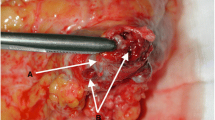Summary
In approximately 4–10 % of patients presenting with renal cell cancer the transluminal propagation of a tumor thrombus into the vena cava inferior or the right atrium comes to diagnosis. Recent investigations have indicated that the presence of neoplastic extension into the venous system does not reveal independent prognostic value regarding the clinical course of the disease. Although the complete surgical removal of vena cava thrombosis in patients without simultaneously occurring regional lymph node or distant metastases has become a well established treatment modality, several questions concerning this surgical strategy still remain the subject of ongoing discussions. In the present investigation that included 92 patients with renal cell cancer and intracaval neoplastic extension it was clearly demonstrated that the use of cardiopulmonary bypass, deep hypothermia and circulatory arrest preferably during the removal of intracaval thrombosis extending into the right atrium does not result in a substantially increased treatment-related intra- or postoperative mortality. However, in contrast to a previously reported observation this treatment option did not reveal any substantial impact on the long-term survival of the patients following surgical therapy. Accordingly, the cranial extension of intracaval thrombosis was not identified as a biological variable of any prognostic importance for renal cell cancer patients.
Zusammenfassung
Bei 4–10 % aller Patienten mit der Diagnose eines Nierenzellkarzinomes (NCC) wird die gleichzeitige Propagation eines Tumorthrombus in die Vena cava inferior bzw. das rechte Atrium beobachtet. Jüngste Untersuchungen belegten die fehlende Bedeutung des Kavathrombus im Sinne einer biologischen Variable von unabhängiger prognostischer Relevanz. Obwohl sich aufgrund der fehlenden Verfügbarkeit suffizienter konservativ-medizinischer Therapiemodalitäten in der Behandlung des NCC der Versuch einer möglichst kompletten chirurgischen Sanierung von Patienten mit Kavathrombus und ohne gleichzeitigen Nachweis regionaler Lymphknoten – oder Fernmetastasen in der klinischen Routine weitgehend etabliert hat, bleiben verschiedene Fragen, diese therapeutische Strategie betreffend, Gegenstand aktueller Diskussion. In der vorliegenden Untersuchung an 92 Patienten mit Nierenzellkarzinom und Kavathrombus konnte gezeigt werden, daß im Vergleich mit konventionellen gefäßchirurgischen Behandlungsansätzen insbesondere die Dissektion rechts-atrial propagierender Tumorthromben mittels extrakorporaler Zirkulation und kardialem Arrest offensichtlich nicht in einer höheren therapieinduzierten Mortalität resultiert. Demgegenüber wurde, wie jüngst postuliert, eine aus dieser operativen Strategie resultierende positive Beeinflussung des Langzeitüberlebens der Patienten nicht beobachtet. Auch die unabhängig vom Operationsverfahren wiederholt diskutierte prognostische Bedeutung der kranialen Thrombusextension konnte in der vorliegenden Untersuchung nicht bestätigt werden.
Similar content being viewed by others
Author information
Authors and Affiliations
Rights and permissions
About this article
Cite this article
Kuczyk, M., Münch, T., Machtens, S. et al. Therapy for kidney cell carcinoma with cava thrombus. Importancy of extracorporeal circulation and prognostic value of cranial tumor extension. Urologe 38, 460–465 (1999). https://doi.org/10.1007/s001200050314
Published:
Issue Date:
DOI: https://doi.org/10.1007/s001200050314




